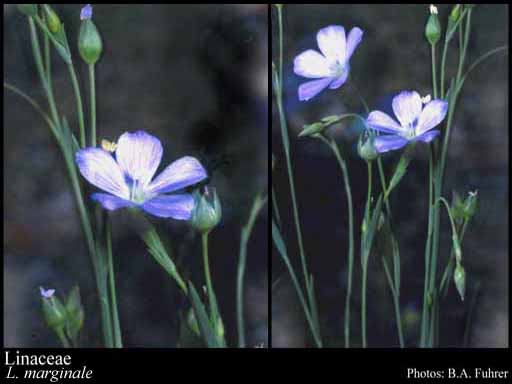- Reference
- Vers.Arzneikr.Pfl. p107 (1818)
- Name Status
- Current

Scientific Description
Common name. Flax Family.
Habit and leaf form. Herbs and shrubs (mostly), or trees (a few). Mesophytic, or xerophytic. Leaves alternate to opposite; usually spiral; sessile; non-sheathing; simple. Leaf blades entire. Leaves with stipules, or without stipules. Stipules small, sometimes represented by glands; caducous. Leaf blade margins entire. Leaves without a persistent basal meristem. Stem anatomy. Nodes tri-lacunar. Secondary thickening developing from a conventional cambial ring.
Reproductive type, pollination. Fertile flowers hermaphrodite. Unisexual flowers absent. Plants hermaphrodite.
Inflorescence and flower features. Flowers aggregated in ‘inflorescences’; in cymes. The terminal inflorescence unit cymose. Inflorescences cincinni or dichasia, sometimes pseudoracemose. Flowers regular; usually 5 merous; cyclic. Free hypanthium absent. Hypogynous disk present (outside the androecium); extrastaminal; of separate members, or annular. Perianth with distinct calyx and corolla; 10; 2 -whorled; isomerous. Calyx 5; 1 -whorled; polysepalous, or gamosepalous (sometimes basally connate); imbricate (quincuncial); persistent; with the median member posterior. Corolla 5; 1 -whorled; polypetalous, or gamopetalous; imbricate, or contorted; regular. Petals clawed (often), or sessile. Androecium 5, or 10, or 15 (rarely). Androecial members free of the perianth; all equal, or markedly unequal; coherent (basally, into a ring); 1 - adelphous. Androecium exclusively of fertile stamens, or including staminodes (often). Staminodes sometimes 5 (alternating with the fertile stamens). Stamens 5, or 10, or 15; isomerous with the perianth, or diplostemonous to triplostemonous; alternisepalous, or oppositisepalous. Anthers dehiscing via longitudinal slits; introrse; tetrasporangiate. Gynoecium 2–3–5 carpelled. The pistil 2–5 celled, or 4–10 celled. Gynoecium syncarpous; synovarious to synstylovarious; superior. Ovary unilocular, or plurilocular; 1 locular (apically only, when the placentas fall short), or 2–3–5 locular, or 4–10 locular (because of extra projections from the carpel midribs which, however, do not reach the central column). Gynoecium stylate. Styles 1, or 3–5; free to partially joined; apical. Stigmas dry type; papillate; Group II type. Placentation axile. Ovules 2 per locule; pendulous; epitropous; non-arillate; anatropous.
Fruit and seed features. Fruit fleshy, or non-fleshy; dehiscent, or indehiscent, or a schizocarp. Mericarps when schizocarpic, 2 (in Anisadenia). Fruit when non-schizocarpic a capsule, or a drupe, or a nut. Capsules septicidal. Seeds endospermic, or non-endospermic; with amyloid, or without amyloid. Cotyledons 2. Embryo chlorophyllous (11 species of Linum); straight. Seedling. Germination phanerocotylar.
Physiology, biochemistry. Aluminium accumulation not found. Photosynthetic pathway: C3.
Geography, cytology, number of species. World distribution: cosmopolitan. X = 6–11(+). 90 species.